What Did We Do This Week?
If you missed class or don’t attend but want to see what sort of prompts we use, we make an effort to archive them here. The most recent class appears first.
These prompts are ready to go anywhere you want to take them. The intention is to spur some writing – even if you write the same sentence over and over. You may like setting a timer for 10-20 minutes. If you are having trouble, change the prompt to suit you and your writing in whatever way works. There is no way to do these exercises wrong. They can be written in any genre (poetry, memoir, fiction, screenplay, note form…) and from a first person, third person, invented perspective, etc.
Each week in class, when we share our work out loud at the table we don’t ask “if this really happened to you.” We like to separate the speaker (the character) of the text from the author (the person who wrote it) of the text. Please do what you need to feel safe, creative and energized by these exercises!
April 20, 2017
Elee led class, with about 25 people. In honour of the Poetry in Voice event later that night that many of us attended, the first prompt was from the definition of “recite”. To recite is to repeat from memory, say aloud, declaim, quote, deliver, render. This was written on the board: “we provided our own entertainment by singing and reciting poetry”.
Prompt: what have you recited, repeated through your life?
Prompt: we looked at a rubric (guideline) for evaluating poetry recitations and changed it to suit our needs.
April 13, 2017 info coming
April 6, 2017
Elee led class today.
Prompt: tell us about the morning you woke up and were 80 ft tall
We spoke about the concept of the last chapbook (We Widen the Margins) and the next one (deadline April 15, How to Live) and thought about how perspective, proportions and size can affect voice. Sometimes, speaking from the margins can be the most powerful position of all. We are able to question, challenge, supplement.
We looked at a page from John D’Agata and Jim Fingal’s The Lifespan of a Fact – a book that started as magazine article by D’Agata that was factchecked by Fingal to such an extent that the conversations that occurred in the margins became the actual book.
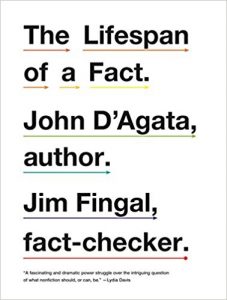
We used coloured paper and each wrote a statement in the middle. The statement could be simple (“I like butter” or “the dog is tired.” The writing prompt was to respond to/answer back/question/factcheck that statement. Many of these were visually beautiful as the authors drew arrows and conversation bubbles.
Our third writing prompt was to take a fresh sheet of paper and write another statement down to pass to the person on the left.
We each took the paper from the person on our right and wrote a response to that phrase. The reading of these was very moving – such a demonstration of trust in handing over our words to each other. We were making a chain of words that works as one long poem.
FOOTNOTE: Unbeknownst to me, Amber Dawn wrote about The Lifespan of a Fact in the National Post a few years ago! Read her 2013 article here.
March 30, 2017
Dear Time, you swallowed us whole, swallowed us lovely, sharp as bones
Crimping sadly under foot my benign, my flotsam and crabs thin as leaves
Your smoothing, your sinking in. Mornings or mooring, or wallowing
Jericho: tapioca air indolent. I am still there, supple and driftwood, you lovely,
You loved me, your memory dark and west, thoughts like tugboats stitching
The horizon, you pulling me, my pudding, my thin crustacean, sideways
In the late afternoon, your gaze, having so soon forgotten the sharpness
Of mornings, the bite of your look serrating the hour: my treasures, all
Of them, for the pleasure of that slice once more, of our dangling,
You and me, the lot of us in some car, driving some hour, mapless.
– from Euphoria, by Sina Queyras
WRITING PROMPT: Write a letter to an abstract idea or emotion.
Some examples you may want to try:
Dear Normal
Dear Regret
Dear Sex Appeal
Dear Craving
Dear Possibilities
Dear Exploding Emotions
Dear Dream Analysis
Dear Foggy Memory
Dear Every Thursday
Dear Laughter
March 22, 2017
Map to the Stars, by Adrian Matejka
A Schwinn-ride away: Eagledale Plaza. Shopping strip of busted
walkways, crooked parking spaces nicked like the lines
on the sides of somebody’s mom-barbered head. Anchored
by the Piccadilly disco, where a shootout was guaranteed every
weekend, those gun claps: coughing stars shot from sideways
guns shiny enough to light the way for anyone willing to keep
a head up long enough to see. Not me. I bought the Star Map
Shirt for 15¢ at the Value Village next to the Piccadilly during
the daytime. The shirt was polyester with flyaway collars,
outlined in the forgotten astronomies of disco. The shirt’s
washed-out points of light: arranged in horse & hero shapes
& I rocked it in places neither horse nor hero hung out.
Polyester is made from polyethylene & catches fire easily
like wings near a thrift store sun. Polyethylene, used in shampoo
bottles, gun cases, & those grocery sacks skidding like upended
stars across the parking lot. There are more kinds of stars
in this universe than salt granules on drive-thru fries. Too many
stars, lessening & swelling with each pedal pump away from
the Value Village as the electric billboard above flashes first
one dui attorney, then another who speaks Spanish so the sky
above is constantly chattering, like the biggest disco ball ever.
Writing Prompt: Write a “word map”
Describe a place you know well is high detail … so much detail a reader could imagine going there for themselves.
March 15, 2017
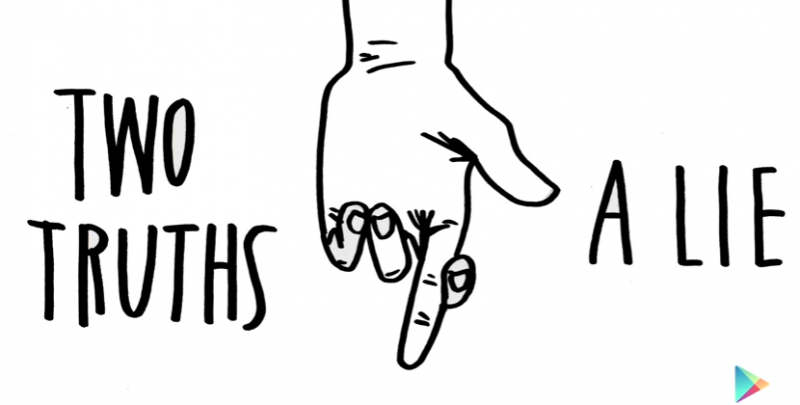 Two Truths and A Lie is a party game where each play takes a turn by stating two truths and one lie about themselves. The other players have to guess which statements are true and which is the lie.
Two Truths and A Lie is a party game where each play takes a turn by stating two truths and one lie about themselves. The other players have to guess which statements are true and which is the lie.
Writing Prompt: Take the concept of Two Truths and A Lie and tell a creative story about a person, place or event. The story should be comprised of mostly truth facts, but also some “lies” or wildly imaginative fictional elements.
For example: Vancouver is a large coastal city that looks at the Pacific Ocean. I’ve lived in Vancouver for 25 years. The year I moved to Vancouver, sea monsters plagued the city. I was warned not to walk alone the seawall at night. The VPD issued a public warning after attacks in Stanley Park. The chief of police had “no comment” about the sea monsters, but more and more witnesses had seen the green monsters near third beach.
You can write about anything – even a personal memoir. You can even use some of your previous writing to get started. As long as you mix some fiction (or “lies) in with the facts.
“Truth is stranger than fiction, but it is because Fiction is obliged to stick to possibilities; Truth isn’t.” Mark Twain
Common Misconceptions
There are a number of “old wives’ tales” out there. Though most of them were refuted years ago, these misconceptions are still commonly believed.WRITING PROMPT: Pick a misconception from the list below (or make one up). Use is as the first line in a poem or story.
We only use 10% of our brains.
Lightning never strikes the same place twice.
Dropping a penny from a tall building will kill someone.
Hair and fingernails continue growing after death.
Cracking your knuckles gives you arthritis.
It takes seven years to digest swallowed chewing gum.
If you drop your food on the floor, it’s safe to eat if you pick it up in five seconds.
One human year is equivalent to seven dog years.
Fortune cookies are a Chinese tradition.
Handling a baby bird will make its mother reject it.
Your blood is blue before it’s oxygenated.
Men think about sex every seven seconds.
February 16, 2017
A creation myth is a symbolic story of how things began. Often these stories are about the sun or moon, the world and the first people to inhabit it.
Write a creation myth of how something BIG began!
Here are some ideas:
- The Cycles of the Moon
- The First Laughter
- The Tallest Tree in Stanley Park
- The First Eagle (or any animal)
- The First Song
- The First Medicine
- The First Romance
- The First Rebellion
- A Shooting Star
- The First Blooming Flower
- The First Garbage (the first time someone littered)
- ANYTHING — get weird and imaginative
** Remember, creation myths aren’t just about how something began, but also about how the rest of existence was impacted by this new creation. What do people, animals and/or other beings think of this creation?
February 9, 2017
A cliché is an expression or idea which has become overused to the point of losing its original meaning or effect, even to the point of being trite or irritating, especially when at some earlier time it was considered meaningful.
BUT what if some clichés are true to life – most importantly your life? Write about a “cliché” that has proven to be true for you in some way.
Here are some sample “clichés” to choose from …
Writers and artists break the rules all the time – like intentionally using clichés in our writing, for example.
Write about the ways and/or the specific times that you have “broken the rules.”
Could you turn this writing exercise into a List Poem? Or a Monologue in a play? Or a rant or song?
November 25, 2016
Today we were visited by poets Jami Macarty and Kevin Spenst, who talked to us about the Words for Bird Project by the Parks Board of Vancouver.
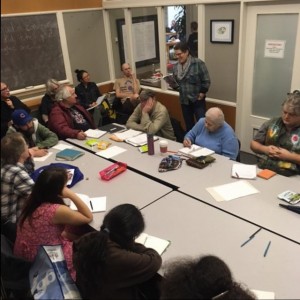
One prompt we worked with: Have you ever had a conversation with a bird? If yes, what did the bird tell you?
November 17, 2016
Today we looked at the palindrome form of poetry. We began by reading this poem by Sandy Shreve”
Dance (palindrome)
Sandy Shreve
From: Bewildered Rituals. Polestar Book Publishers, 1992.
this is how the body can move
with grace and fortitude
remember them, two men
to the beat of one drum
their gymnastic limbs swinging
over and under, around
in the soft night air of a park
karate kicks just this far from skin
never come to blows
hands open into air
slow motion, a precision pose
anger transformed to the beautiful
in a dance
in a dance
anger transformed to the beautiful
slow motion, a precision pose
hands open into air
never come to blows
karate kicks just this far from skin
in the soft night air of a park
over and under, around
their gymnastic limbs swinging
to the beat of one drum
remember them, two men
with grace and fortitude
this is how the body can move
Then we picked an action-based activity to write about. After completing short paragraphs or stanzas, we then attempted to run or writing backwards to form a palindrome. Some of the actions we wrote about where: riding a train through the rocky mountains, eating, cooking, writing poetry, dreaming, dancing, etc.
October 20, 2016
Portal Fantasy Story Exercise # 1
Finish (or completely change) this story …
At first, everyone was afraid of the large black geometric hole that appeared on the corner of Main and Hastings. “It’s a kind of portal, a door,” someone guessed.
“What do you suppose will come popping out of there?” another person asked. As the portal hovered outside of Carnegie Centre a crowd gathered, waiting for someone or something to emerge from it. The portal felt warm to those who got close to it. Those who listened closely heard a kind of lovely music leaking through from the other side. People asked more questions.
“Maybe it’s a one way door?”
“Maybe one of us should go through it?”
WRITING PROMPT: Imagine that you have a strong, positive feeling about the portal. You are 100% certain that you can go through it and return again safely. Write a fantasy story about visiting another world, a world where you might find beauty, deeper knowledge, and strange but wonderful sites.
Let your imagination be free!
October 6, 2016
Today we listened to poet Mary Oliver read “Wild Geese” (below as an mp3)
We enjoyed Oliver’s combination of emotions and ideas alongside the sensory, concrete imagery.
Try this Metaphor generating writing technique –
Pair emotion or ideas + tangible imagery that can be perceived by the 5 senses. The 5 Senses are: sight, hearing, touch, smell and taste
Some possible emotions or ideas:
Love
Comfort
Belonging
Freedom
Healing
Faith
Creation
Memory
Strength
… [Your Choice]
What images would you pair with one or more of these emotions? What sights, sounds, smells, tastes or textures?
These images can come directly from your personal experience, OR, the images from the larger world around you.
September 29, 2016
Today we read a List Poem by Jill Battson for inspiration, then modeled our own writing exercise from Battson’s poem. The poem and suggested prompts are:
36 reasons why I want to grow a garden by Jill Battson
Because I want to plunge my hands into dark rich soil
Because I want to sweat as I labour over the fork
I want to taste the salt as I sweat
I want to smell hard work on my body
I want my muscles to ache and then be soothed by soft rain
Because I want the open canvas of tilled land
I want the beauty of level earth, prepared
I want honest calluses on my hands
Because I want to feel the rough sleeping seeds
tumble through my fingers into the ground
I want to smooth them over with a blanket of soft loam
I want to watch the birth of green shoots
as they push themselves towards the sun
Because I want to lie next to the garden listening to the plants grow
I want to smell the earth after rain and after sun
I want to nurture the seedlings into plants
support them with poles and trellises
I want to talk them through their adolescence
Because I want to watch flowers pollinated by bees and butterflies
I want to see the first fruit smell the sun warmth of a fresh tomato
Because I want to crush aromatic basil plants in my arms
I want to feel the heavy stalks of corn against my body
I want to see my hands stained by the chlorophyll of their existence
I want to watch the plants shine in rising vermilion sun
and glow in the silver of a full moon
Because I want to listen to their chatter as they decide their destiny
I want to harvest the fruit of my labour
I want to relish each individual vegetable shape in my hands
drink their beauty with my eyes
Because I want to feel their unique presence in the world
I want to press them against my face to feel their textures
I want know that when I cook them they will be minutes old
clean of pesticides and pollution
and when I serve them
ripe, brilliant and ready on white china
I want to know that you’ll be there
Suggested Prompt: Write A List of Reasons Poem
___(any number) ___ of reasons I want to …
… write poetry
… paint / draw / sew / make art
… pray
… be kind and conscious of others
… make people laugh
… be true and loving to myself
… (anything you choose)
**This exercise yielded some excellent writing today. We hope to show you come of the work in an upcoming chapbook or online.
September 22, 2016
Congratulations to the finalists for the Vancouver Book Award. The City of Vancouver has gifted us a copy of each book.
Today all of our writing exercises were in response to Lawrence Paul Yuxweluptun: Unceded Territories.
Lawrence Paul Yuxweluptun: Unceded Territories by Lawrence Paul Yuxweluptun, Karen Duffek and Tania Willard, which is a provocative art book that celebrates Lawrence Paul Yuxweluptun’s artwork as expression of Indigenous rights in the unceded territory known as Vancouver.
We read quotes from Lawrence Paul Yuxweluptun’s artist statement and looked at his paintings. Some quotes we highlighted are:
“Your back rent is due, British Columbia.” – LPY
“I’m looking at global issues … the one percent of the planet that tells the rest of the world what to do … [they] want to destroy whatever they want and take whatever they want. British Petroleum (BP) is an example.” -LPY
Suggested Prompt: How could British Columbia pay up? How might government officials or greater BC society pay some form of rent to Coast Salish Peoples?
Suggested Prompt: What – on these unceded lands – needs protection? What needs love, respect and protection?
We focused on the these paintings:
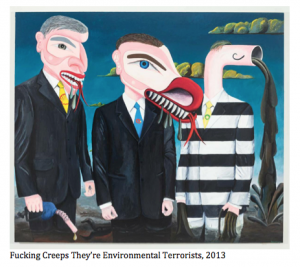
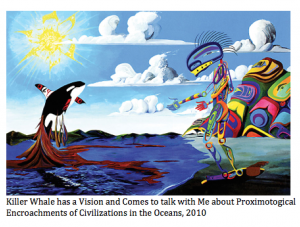
September 15, 2016
TWC regrouped today. Today we celebrated our welcome back writing class!
We wrote a (Word) Portrait of Our Hands
Many visual artists claim that hands are most difficult body part to draw. This is because hands are expressive. Hands can be as expressive as our facial features.
Suggested Prompts:
- If your hands could speak, how would they introduce themselves?
- What activities do your hands enjoy best?
- What are some life highlights or strong memories your hands hold?
- Is your left different from your right? How?
- What are some goals your hands have?
* * * * *
Our Sustain and Nourish project for 2015/6 is in cooperation with Vancouver Poet Laureate Rachel Rose’s three-year investigation into food, community and poetry. As one of her “Poetry Ambassadors” Elee Kraljii Gardiner is happy to share these prompts and ideas with the larger public. If you use them in workshops or teaching, let us know how they do – and please give a nod of credit to Thursdays Writing Collective.
June 9, 2016
Our last class of course 17! We had snacks (veggie and fruit trays, cookies and brownies, coffee). We responded to interview questions from Sachiko Murakami for her blog WritingSoHard.com
Prompt: inside the picnic basket
Here are the questions we answered for the blog:
- What’s the hardest thing about being a writer? Or: What’s hard about being a writer?
- What do you do to overcome [whatever your answer was to the first question]?
- What are you doing when you’re not-writing?
- How does not-writing feel compared to writing?
- Is procrastination a problem? Writer’s block?
- What would you rather be doing than writing?
Our last order was to discuss what people need for the summertime to support their writing. Karenza looked into holding our room booking for the summer so people can informally come together to write. This will be a sort of “Meet up and Write” session.
We spoke about the launch, too. (Thurs June 16, 7-9pm, Lost +Found Café, 33 W Hastings) Remember to bring you own chapbooks to sell!
Cara has offered to facilitate feedback workshops after classes in the fall. More on that as it develops.
Have a great summer!
June 2, 2016
Prompt: miniature food jewelry
Prompt: eat his hat/clothes made of food
Prompt: how superheroes eat their food
Prompt: (We didn’t get to this one) Do eagles eat the bones of their prey? Yes, and the bones provide important nutrients. The acids in the eagle’s digestive system are strong enough to dissolve bones, which are completely digested.
We also spoke about plans of our launch and discussed summer plans.
May 26, 2016
We held a Literary Verses and Courses event at Heartwood Community Café with Amber Dawn and Cease Wyss. Beautiful food, a great talk from Cease about First Nations herbology and growing, some writing and an open mic. Even a vegetable carving contest!
May 19, 2016
Jan Tse surprised us with cakes! She brought in an entire party! Thanks to Jan and her pal Darryl for arranging everything, down to the coffee. We have worked hard this year and achieved many milestones of publication, performance and so forth. It was wonderful to celebrate and our light-hearted class reflected that.
Prompt: a meal for 100 people
We spoke about a tradition in Syrian families is to cook communally. Everyone pitches in and is able to feed a large gathering. A restaurant cooking space in Toronto, The Depanneur, offered its space to Syrian refugees who were in hotels without kitchens. The women came together and cooked and ate and then brought food back to share with their families.
Prompt: How do you make an apple turnover? Push it down hill. http://www.jokes4us.com/miscellaneousjokes/foodjokes/applejokes.html
Prompt: pictures of carved and posed vegetables and fruits – a nod to our Sustain and Nourish thinking! We offered anyone who wants to try carving one of these in their own way a chance to try that out to bring to our social writing event next week at Heartwood Community Cafe where we are holding class, 2-4pm. We’ll have a country fair style display and entrants will be reimbursed $5 for material fees!




May 12, 2016
Prompt: fridge magnet collection
Prompt:
We looked at this list of collective nouns:
A bed of clams
A soufflé of clouds
A colony of fungi
A dish of gossips
A delicatessen of gourmands
A formality of penguins
A run of poultry
We read Madhur Anand’s “Two Jars” from New Index for Predicting Catastrophes. It’s a beautiful poem about heritage, recipes, identity and immigration.
We also did a close reading of Monty Reid’s “Cork” from Meditatio Placentae which elicited a lot of discussion and a mention of Neruda’s odes.
May 5, 2016
Anne facilitated class.
We moved on to lunch and dinner this week, and the writing was as descriptive and rich as last week, from dim sum memories to family rivalry played out around dinner.
The first prompt was “lunch.”
Before moving to dinner, we thought about foods that provoke deep memories. This was the reading.
Marcel Proust’s Remembrance of Things Past
And suddenly the memory returns. The taste was that of the little crumb of madeleine which on Sunday mornings at Combray (because on those mornings I did not go out before church-time), when I went to say good day to her in her bedroom, my aunt Léonie used to give me, dipping it first in her own cup of real or of lime-flower tea. The sight of the little madeleine had recalled nothing to my mind before I tasted it; perhaps because I had so often seen such things in the interval, without tasting them… But when from a long-distant past nothing subsists, after the people are dead, after the things are broken and scattered, still, alone, more fragile, but with more vitality, more unsubstantial, more persistent, more faithful, the smell and taste of things remain poised a long time, like souls, ready to remind us, waiting and hoping for their moment, amid the ruins of all the rest; and bear unfaltering, in the tiny and almost impalpable drop of their essence, the vast structure of recollection.
And once I had recognized the taste of the crumb of madeleine soaked in her decoction of lime-flowers which my aunt used to give me (although I did not yet know and must long postpone the discovery of why this memory made me so happy) immediately the old grey house upon the street, where her room was, rose up like the scenery of a theatre to attach itself to the little pavilion, opening on to the garden, which had been built out behind it for my parents (the isolated panel which until that moment had been all that I could see); and with the house the town, from morning to night and in all weathers, the Square where I was sent before luncheon, the streets along which I used to run errands, the country roads we took when it was fine…and the good folk of the village and their little dwellings and the parish church and the whole of Combray and of its surroundings, taking their proper shapes and growing solid, sprang into being, town and gardens alike, all from my cup of tea.
I then asked the writers to think about point of view and conversation before beginning, specifically about meals eaten alone, other people’s meals observed and odd dinner conversations.
A New Yorker article by Bee Wilson, Pleasure of the Literary Meal (July 15, 2015) introduced ideas about the meal gaze, eating alone, and observing the indulgence of others. The last reading was from the tea party scene in Alice in Wonderland. Attended by the Hatter, a dormouse that keeps falling asleep, and the March Hare, the conversation shifts from personal remarks to riddles, upending rigid social rituals in the process.
The three prompts, from which the writers could choose one or more, or none, were:
Sometimes, a bowl of noodles is all the companionship you need.
From outside, I watched them eat dinner.
“Who is making personal remarks now?”
April 28, 2016
Anne facilitated class while Elee was away. Class began with “breakfast” (the prompt), a simple word, loaded with potential, which the writers fully grasped. Almost everyone read their writing, taking us on a journey from Looks Both Ways Woman’s touching and powerful story of summer breakfasts with her family that began with her grandfather’s 4am prayer to the four directions, to Patrick’s comic tale of massive amounts of pancake prepared by his father and consumed by him in record-breaking numbers.
Meals mark our days, provide ritual, and reveal character. For this class and the next, that’s our exploration. Here is what was read about breakfast:
Breakfast is the most habitual meal of the day, a routine so key to inner wellbeing that Hunter S Thompson called it a “psychic anchor”, drawing, uncharacteristically, on an image of weighty predictability. If somebody is having toast with marmalade this morning (or, in the case of Thompson, “four Bloody Marys, two grapefruits, a pot of coffee, Rangoon crepes, a half pound of either sausage, bacon or corned-beef hash with diced chillis” plus quite a few other things), it is a safe guess that they had it yesterday and that they will have it tomorrow as well.
Breakfast is the ideal barometer of normalcy, the meal that tells us who a person really is. An example: in the fifth chapter of Moby Dick (simply called “Breakfast”), Melville offers a morning scene at a bar-room in a whaling town, as a way of painting us a picture of Queequeg, a Pacific islander who “eschewed coffee and hot rolls” – savagery! – and “applied his undivided attention to beefsteaks, done rare”.
Meticulous breakfast prep often signals violent tendencies, providing a bracing contrast, an ultra domesticity to balance out the brutality to come. For instance…Patrick Bateman, the investment banker in Bret Easton Ellis’s American Psycho exhibits his psychopathic tendencies, sure, by murdering several people in horrific fashion – but also in the creepy and ultra-detailed way that he describes the breakfasts of his yuppiedom:
“Standing at the island in the kitchen I eat kiwifruit and a sliced Japanese apple-pear (they cost four dollars each at Gristedes) out of aluminum storage boxes that were designed in West Germany. I take a bran muffin, a decaffeinated herbal tea bag and a box of oat-bran cereal from one of the large glass-front cabinets… I eat half of the bran muffin after it’s been microwaved and lightly covered with a small helping of apple butter…” and so on, and so on.
The second prompt was “breakfast.” Again. But this time, we wrote about someone else’s (fictionalized or not) breakfast preparation or their meal. There were again many memorable pieces, including Karenza’s story from age five, watching her elderly neighbour prepare tea and chapati in their shared courtyard in India.
With only 40 minutes left and announcements remaining, we decided there wasn’t time for another meal. We turned to play. The prompt: Phantasmagoria, a confusing or strange scene that is like a dream, because it is always changing in an odd way.
April 21, 2016
Prompt: another word for what I eat
I’m thinking about vocabularies and how they change according to socio-political situations. For example, in English we have several words for the same thing: pig/pork, cow/beef. Why?
Prompt: Here’s a list of words listed as synonyms to “food”
We looked at two different sets of synonyms for the word “food.”
Each person read one word aloud. That word became their prompt to write to/react to in any way. They could invent a definition or they can use the word in a story.
Other options included: use every single word from one poem in a list; write an antonym list; complete the list with other words, etc.
We had fun with these words:
List 1
motion, with reference to direction
ichthyophagy
manducation
mazard
chops
epulation
hippophagy
List 3:
maintenance, perpetuation, support; sustenance
April 14, 2016
Prompt: I found a key in my garden
Prompt: The price of sugar
In class, we explored what is sometimes hidden when thinking about food, like that key you find buried in the earth near the carrot, and the fact that the price of sugar impacts our political lives. The first prompt sparked some creative discoveries, like Patrick’s story of youthful trouble-making, many keys that unlocked the heart, and Cara’s psychological poem about a key buried deep in the earth.
Next, Anne introduced ideas from a recently published book, the end of protest: a new playbook for revolution by Micah White. White is the co-creator of the Occupy Wall Street movement. He believes that the forms of protest as we know them are obsolete, and offers new ideas about how to move forward to create change. I read a passage from his section on structuralist activism, which purports that activists don’t influence change, but that it comes from outside forces. One of those sources is the price of sugar. The passage we shared in class is below.
The writing from this prompt was powerful. The many voices of the group brought such rich perspective to ideas of sugar, pricing and protest. Some of the writers are working on their pieces this week, and we hope to include some here on the website or elsewhere once they are completed.
We also had a discussion about where we are this year on “Sustain and Nourish” and talked a bit about what we expect for next year.
Another energetic class!
Also I am handing out, quartet by quartet, T.S. Eliot’s “Four Quartets.” Yesterday we got East Coker. Since we didn’t have time to read, or talk about it, here are some notes I took to class that might help with the reading.
Notes on East Coker
East Coker is the name of the village in Somerset England where Eliot’s family lived before moving to America. This is considered the most dismal of the four sections. It describes the war that was going on at the time of writing and Eliot’s feelings about the failures of his poetry. It also considers the place of man in the natural order, referencing Christianity, including Ecclesiastes (natural cycles and harmony) and Good Friday (the guilt of humans in the death of Christ). The sections within the Quartet describe: first, the cycle of renewal and decay; second, poetry; third, death; and fourth, war.
April 7, 2016
Prompt: “He transformed a ring of keys, a kitchen knife, or a simple wooden frame into art.”
This extracted quote is from a longer one by Patti Smith I found on Quotenik:
“It is said that children do not distinguish between living and inanimate objects; I believe they do. A child imparts a doll or tin soldier with magical life-breath. The artist animates his work as the child his toys. Robert [Mapplethorpe] infused objects, whether for art or life, with his creative impulse, his sacred sexual power. He transformed a ring of keys, a kitchen knife, or a simple wooden frame into art. He loved his work and he loved his things. He once traded a drawing for a pair of riding boots—completely impractical, but almost spiritually beautiful. These he buffed and polished with the devotion of a groom dressing a greyhound.”
We went on to talk about the materiality of writing, the pen or pencil, the paper – how we use these materials to create art. I brought in a basket full of weird kitchen implements. Some of them were familiar and some of them more esoteric. We each chose one and then wrote a microscopic study of it. What does it feel like? What parts does it have? What is it’s heft?
After that close study we drew up quick lists of alternative uses for the object. These ranged from ladybug swimming pools (for a teeny spoon) to face mister (for a citrus pump). Yes, we were laughing.
The third part was to write a “high art critique” of the object as if we were reviewing the object in a museum. These, too, surfed from insightful (what is art? what are the qualities of art important to me?) to ridiculous.
March 31
Elee was away in LA at the AWP conference so Anne led class on “Senses and Similes”.
We began with the prompt “broccoli forest.” The responses were fantastic, literally, blooming from the writers’ creative minds. The distortion of proportions (broccoli to forest) led to all sorts of fun investigations of the world. We then jumped off the food truck for a short bit, first reading two of Elee’s poems from serpentine loop– to support her book signing in Los Angeles and send her our love — and then reading the first two sections of T.S. Eliot’s “Burnt Norton” from the Four Quartets, a poem I love for its sublime combinations of the abstract and concrete.
The writers naturally picked up on the power of combining the tangible with the intangible when they responded to our first sensory prompt. Writing to “seeing” (in silence), which was magical. Cathy Lau’s piece, read here, pretty much sums up the classroom experience.
Then I rushed everyone through two more prompts: touching and smelling mint leaves from my garden; and listening to the sound of apples being eaten.
Here are two poems written by Luc Paradis in response to the prompts.
Broccoli Forest
Broccoli forest; ever so green,
the thickest forest you ever did see,
full of ferns and flowers that grow with might
and squirrels and birds – oh what a sight!
The sun does shine and peeps through the trees.
I let the sunshine wash over me.
When it rains it does so with joy,
it plays with the rainbows like a magical toy.
Broccoli forest, a magical place,
nothing quite like it from here to the space
between heaven and the stars, if you squint you can see it
from so close or from far.
Apple Crunch
The crunch, the sound it brings to one`s ear,
a kid`s Captain Crunch, who smiles ear to ear.
Like the sound of a ball being chewed by a dog
or a beaver chewing the end of a log.
It all sounds crunchy, no word of a lie.
If you wonder at all, just wonder why.
I was determined to finish, and maybe moved too fast because there wasn’t much time for reading in the end. But I certainly had fun watching everyone respond in different ways of wonder and words. Thanks again to the writers for their kindness to me, and for letting me play this past Thursday.
March 24, 2016
Prompt: Lessons lettuce
This small, bizarre combination of words come from Gertrude Stein’s Yet Dish.
It is from stanza XXXVI, which reads:
Lessons lettuce.
Let us peer let us polite let us pour, let us polite. Let us polite.
We spoke about Stein, and the bare facts of her bio:
Gertrude Stein (1874–1946 ) was a central figure in the Parisian art world. An advocate of the avant garde, Stein helped shape an artistic movement that demanded a novel form of expression and a conscious break with the past. She rejected the linear, time-oriented writing characteristic of the nineteenth century for a spatial, process-oriented, specifically twentieth-century literature. The results were dense poems and fictions, often devoid of plot or dialogue, which yielded memorable phrases (“Rose is a rose is a rose”) but were not commercially successful books.
We read the entire poem stanza by stanza out loud going around the table. We listened to it and let it be as sounds rather than forcing a narrative coherency into the words. Some of us read quickly, some of us played with emphasis, some giggled, some absolutely HATED it!
We talked about the struggle of meaning. We also touched on postmodernism and classism – does postmodern critique separate journeyman writers from academic stars?
Next we read a different sort of poem also touching on food:
Eating Together by Kim Addonizio
This poem is shorter, narratively clear, contemporary. For some it was a relief. We did a close reading of it. It was a great counterpoint to “Yet Dish.”
Our writing prompt after that reading was to find a phrase or line or word form either Stein’s or Addonizio’s poem and to create something new. Several people mashed them up and used the “sound-ness” of Stein to write about loss or grief. Others tried to break meaning entirely.
March 17, 2016
Elee was away and Anne Watson facilitated class. Our first prompt was “Humans are born craving sugar,” which led to much discussion about whether this is true or not biologically, and how much culture and advertising influence our cravings.
The second prompt took us into a pitch black restaurant. Dark Table is a Vancouver restaurant, but the concept came from the dinner table of a man without sight in Switzerland. He wanted his friends to experience food as he does and invited them over for meal in total darkness. The experience was so profound for his friends that they encouraged him to continue the dinners for others…and he did. Eventually, these dinners evolved into restaurants in European, U.S. and Canadian cities. Our prompt was an invitation to the writers to enter a room where blind waiters served them food in total darkness. The writings were funny, profound, sometimes terrifying, sometimes trusting and as always excellent.
March 10, 2016
Despite the Pineapple Express storm that had power outages happening across the city, more than dozen TWC writers donned their rain gear and climbed into the Carnegie Community Centre van driven by Rika Uto. Thanks, Carnegie, for supporting us! The Law Students we worked with last week met us at the UBC Farm Yurt with a warm welcome. The rain had stopped and the students provided a banquet of baked goods for our session.
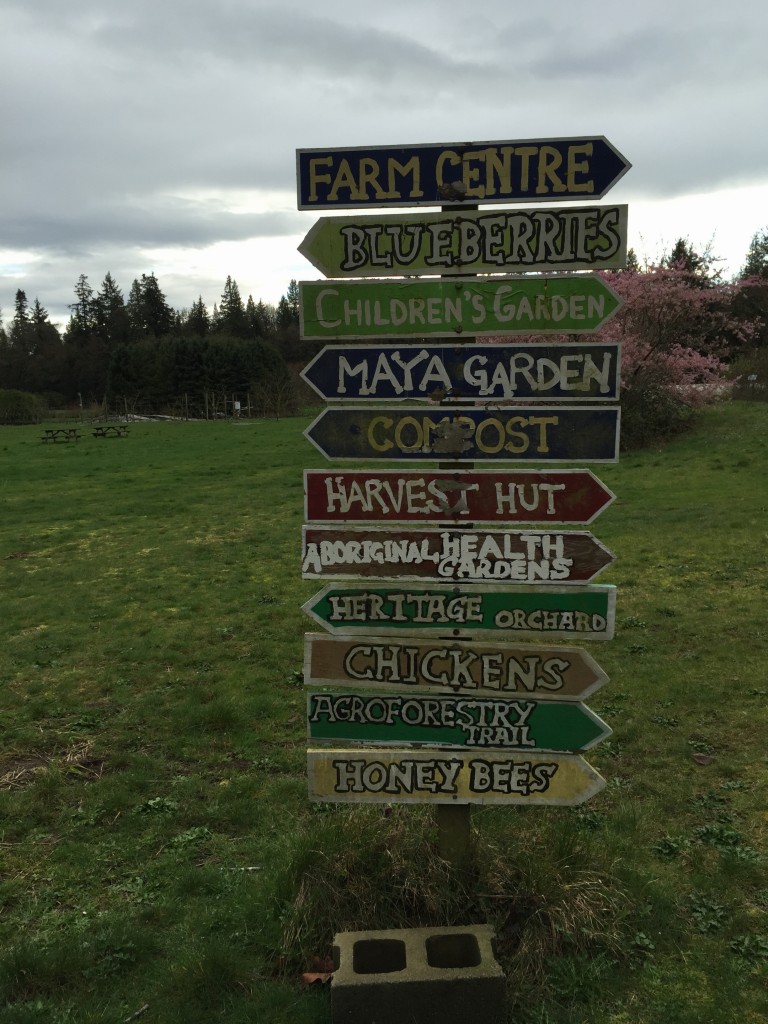
We started off with a short reading from Heat by Bill Buford about the various names of pasta in Italy and the concept of being playful with food. We shared pieces of writing including an allegory about peas and knives, pieces about stealing milk off doorsteps to survive as a foster child, a poem about porridge, watching a person eat leftovers abandoned by a customer in a restaurant, reintroducing the concept of the body into a list of “hunger” words, a poem about pearls dissolving in vinegar, coming home to a rat, a vivid piece about caribou, broken promises by the government about feeding everyone, noticings about the food bank at UBC, thinking about cooking as self-care and self-sufficiency, food deserts – including in the Yukon where one person remembered roads washing out and grocery store shelve running bare, parents leaving kids to find work and provide food, food as language, northern cargo costs for First Nations people shipping food home.
Several people shared recipes! Here’s a picture of Prof Margot Young with the recipe from inside a box of Baker’s Chocolate she used to make brownies for us. She linked the recipe with the important moments in her life she bakes them for – it was a funny story but also poignant in that it highlights how we use food to commemorate and connect.
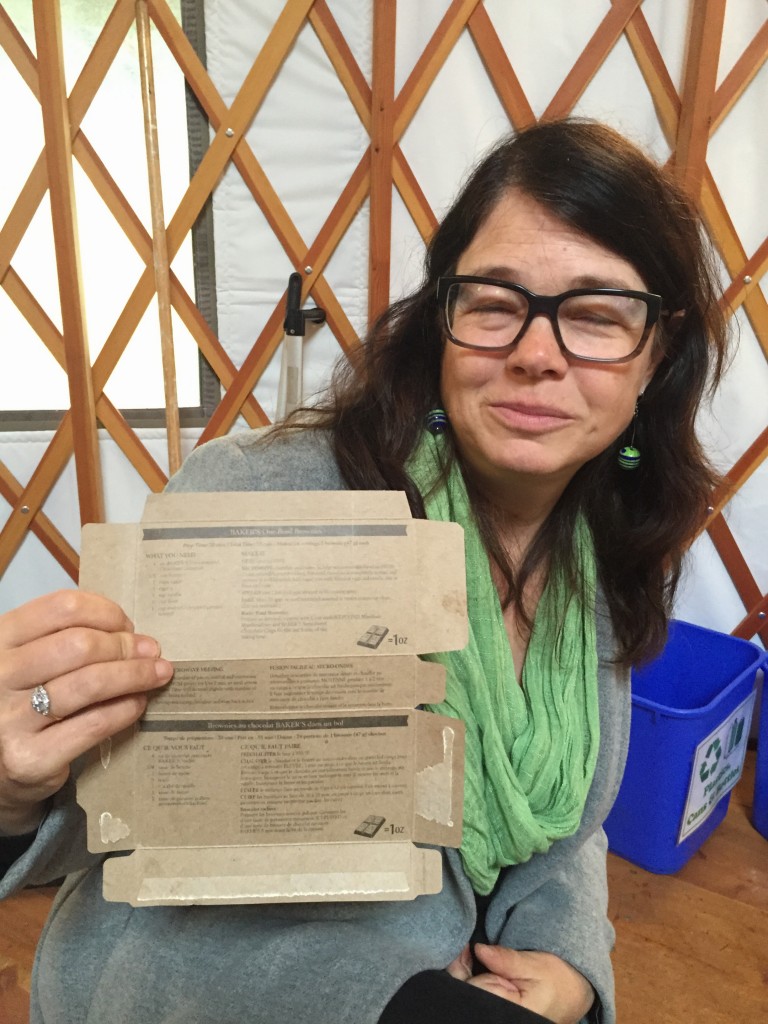
The other recipes came with beautiful stories, too, which I won’t share here out of respect for personal details. Let us know if you try these out!
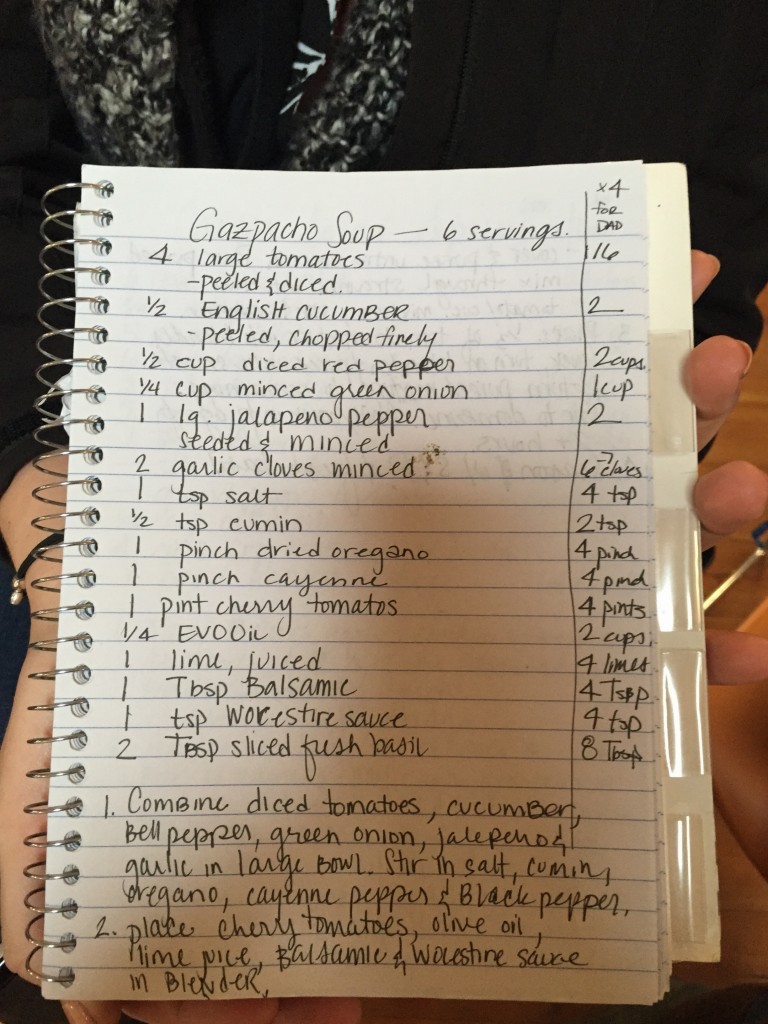
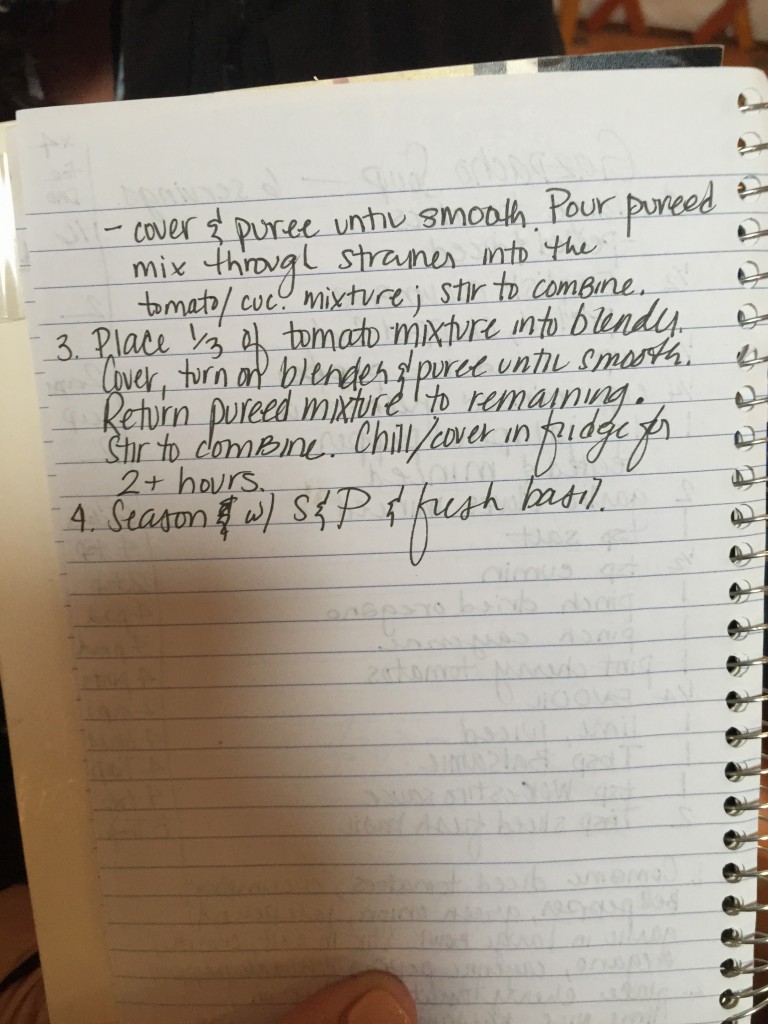
Thanks to everyone who made this trip a meaningful exchange.
We really enjoyed our abbreviated tour with Veronique, the farm manager. She told us about the indigenous herb and food gardens where plants are grown to support First Nations medicine and she showed us the salmon smoker built by Engineering students to connect with local food traditions. The smell of the earth after the rain was delicious and worked its own magic on us all.
We finished our visit with a photo:
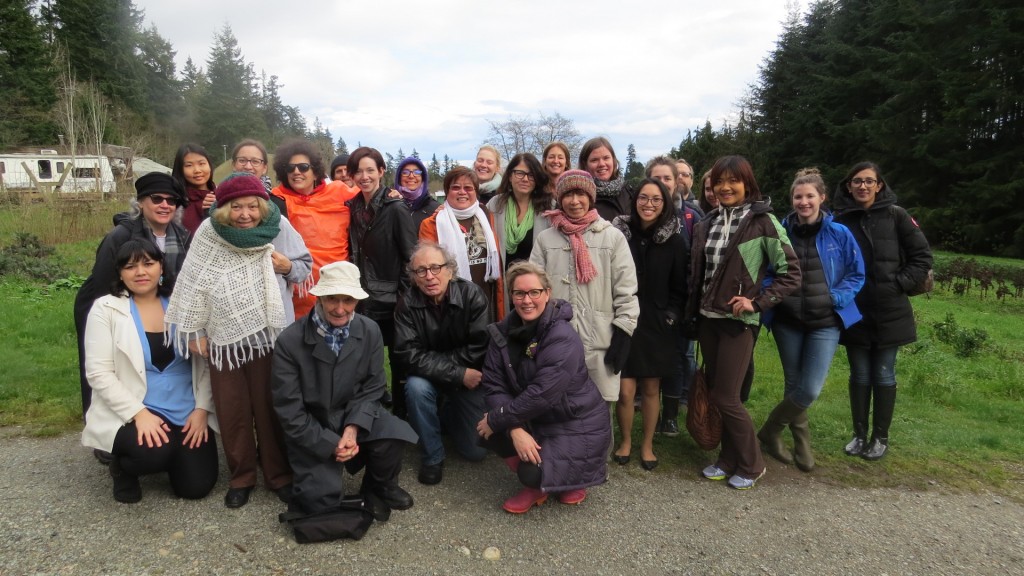
March 3, 2016
We had a visit with UBC Law Professor Margot Young and her 3rd and 4th year students interested in social justice. They came to write with us. The first prompt was:
“Ask not what you can do for your country. Ask what’s for lunch.” Orson Welles
We discussed how focussing on the immediate is a radical act, linked to liberation theology, linked to the importance of attending to critical issues at hand versus theoretical ones.
Margot brought an assemblage of ideas, some of which we wrote to/off and others we discussed. In no particular order:
- An assortment:
- food poverty
- food poor
- food sovereignty
- food first
- “zero hunger” policy
- good security
- the right to adequate food
- homo economicus
- “steady drip of welfare residualism”
- “right to food has legs”
- legal obligation
- domestic hunger
- Respect the right to food. Protect the right to food. Fulfil the right to food.
- “The contradiction between unrestrained waste, economical unsustainability and growing food poverty is ethically intolerable.”
- Hunger is political and emotional
- Hunger: biological, social and economic
- “surplus and wasted food to feed hungry people”
- “food expenditure is the most flexible part of the budgets of vulnerable people”
- “Food bands as symptoms and symbols of welfare states in decline if not in crisis”
- “food charity acts as a moral safety valve and…it de-politicizes First World hunger as an issue requiring the full attention of states and their governments”
- “institutionalization, corporatization and globalization of charitiable food banking”
- Richest countries in the world can’t guarantee food security
Then we looked at the Food Donor Encouragement Act and discussed the politics of protecting donors from repercussions of harm done to consumers of the food donated. This was an interesting discussion.
Food Donor Encouragement Act
Assented to May 26, 1997
HER MAJESTY, by and with the advice and consent of the Legislative Assembly of the Province of British Columbia, enacts as follows:
Liability of donor
1 A person who donates food, or who distributes donated food, to another person is not liable for damages resulting from injuries or death caused by the consumption of the food unless
(a) the food was adulterated, rotten or otherwise unfit for human consumption, and
(b) in donating or distributing the food, the person intended to injure or to cause the death of any person who consumed the food or acted in reckless disregard for the safety of others.
We didn’t LOVE the language. We wrote about the prompt. Some of us subverted it by doing erasures or inhabitations:
Here’s the poem of the circled words:
Encouragement
Her advice and consent enacts
a person to person fit
person to person special rapport
the right strategy
We continued to think about other lines below lifted from chapters of readings assigned to the law students: “Canada: Thirty Years of Food Charity and Public Policy Neglect” by Graham Riches and Valerie Tarasuk and “Hunger in the Rich World: Food Aid and Right to Food Perspectives” by Graham Riches and Tiina Silvasti.”
“Canada has long been seen as a land of plenty. Yet today one in ten families with a child under six is unable to meet their daily food needs. These rates of food insecurity are unacceptable, and it is time for Canada to adopt a national right to food strategy,” said Olivier De Schutter, the UN Special Rapporteur on the right to food.
- Social assistance is like a blanket that is too short…”If you cover your head, your feet will stick out,” she said, “On social assistance you must choose between paying for rent or food.”
Then we looked quickly at a sheet of ideas Margot brought:
Hunger is not an issue of Charity, it is an issue of Justice.
Ways to my heart.
- Buy my food.
- Cook me food.
- Be food.
You can’t buy love but you can buy cupcakes and that’s sort of the same thing.
Food is a passion. Food is love.
Food is culture, habit, craving, and identity.
I love you more than food. That’s a lot.
Hangry: a state of anger caused by lack of food.
If a pot is cooking, the friendship will stay warm.
Food is the moral right of all those born into the world.
“One cannot think well, love well, sleep well if one has not dined well.” Virginia Woolf
We didn’t get to all of them. The conversation was excellent and we applaud the Law Students for jumping in and writing with us. They were fantastic!
February 24, 2015
Prompt: “Probably one of the most private things in the world is an egg, until it is broken.” – Fisher, from the original book
Prompt: saliva is salty (p.70, The Man Who Ate Everything by Jeffrey Steingarten)
Prompt: ketchup – 97% of American homes stick ketchup; each American eats three bottles a year (p. 93 The Man Who Ate Everything (by Jeffrey Steingarten)
Prompt: “Knowing how to clean a fish was an innate as knowing how to open a door.” – Marcus Samuelsson, Yes, Chef
February 18, 2016
Welcome back from winter break! We had a raucous return. We had a visit from First Nations artist Teresa and manager James from the Skwachay Lodge, a groundbreaking hotel/artist residence just around the corner. We plan to do some collaborations with them next year for our project about the Visual. Teresa drew a response to a prompt – lovely!
Prompt: The Man Who Ate Everything (title of book by Jeffrey Steingarten)
Prompt: How to Cook a Wolf (title of book by MFK Fisher from 1942)
Prompt: “Her chapter titles themselves are gems that provoke an irresistible desire to find out just what on earth she means by them: ”How to Distribute Your Virtue,” ”How to Boil Water,” ”How to Greet the Spring,” ”How to Be Cheerful Through Starving” ”How to Pray for Peace,” ”How to Be Content With a Vegetable Love” and ”How to Have a Sleek Pelt.” –Orville Prescott
Writers created their now “how tos”
December 10, 2016
This was our last class for the year. We meet again on Feb 18, 2016 at 2pm.
Just a reminder to please SAVE YOUR WRITING from class. Yesterday’s words (and those from the past weeks) should not be lost or forgotten. In the spring we will select what to include in our next publication. So please, please save what you’ve written!
Still jetlagged from returning from a conference in Thailand, Elee sat and wrote while Anne Watson led class.
Here’s what we did yesterday…a day of fantastic, magical writing!
The subject was “Playing with Food.” We talked about Magical Realism, Lewis Carroll’s genre of literary nonsense, and what it’s like for people with synesthesia.
Prompt: Mules munching bumblebees and cows sipping chamomile tea
Prompt: Associate three words with these letters, one must be a food, and write about them in relationship to each other. Try to create groups that have contrast, such as made by hand vs natural, or light vs. dark, alive vs. inert.
You could associate one object with the food you chose and try to work with it like a synethesete, like Tilda Swinton. Make it a scene, a poem, a conversation or an essay. To bring the subject of synesthesia back to food, we spoke about the actress Tilda Swinton and her description of her particular synesthesia. She connects words to food or as she describes it “sees different edible item with the words she uses.” For instance, the word, “word” is a kind of gravy. Table is a slightly dry cake. Tomato is not tomato but lemony.
Here’s what was on the handout.
Magical realism –fiction that accepts magic in the real world.
This is a sampling of famous people with synesthesia: Salman Rushdie (India, 1947- ), Gabriel Garcia Marquez (Columbia, 1927-2014), Jorge Luis Borges (Argentina, 1899-1986), Franz Kafka (Czech,1883-1924, metaphysical realism), Isabel Allende (Chili, 1942), Toni Morrison (US, 1931- ), Louise Erdrich (Turtle Mountain Band of the Chippewa – US, 1954,).
Lewis Carroll, the author of Alice in Wonderland, experienced synesthesia and a type of neurological reality that changed the way he looked at (and wrote about) the world:
Quotes from “Alice in Wonderland” by Lewis Carroll (that include food!)
“Why, sometimes I’ve believed as many as six impossible things before breakfast.”
“Take some more tea,” the March Hare said to Alice, very earnestly.
“I’ve had nothing yet,” Alice replied in an offended tone, “so I can’t take more.”
“You mean you can’t take less,” said the Hatter: “it’s very easy to take more than nothing.” “Nobody asked your opinion,” said Alice.”
“The time has come
The walrus said
To talk of many things:
Of shoes- and ships-
And sealing wax-
Of cabbages and kings-
And why the sae is boiling hot-
And whether pigs have wings.”
― Lewis Carroll, Alice in Wonderland
Vladimir Nabokov’s description of his synethesia:
“The long a of the English alphabet …has for me the tint of weathered wood, but a French a evokes polished ebony. This black group also includes hard g (vulcanized rubber) and r (a sooty rag bag being ripped). Oatmeal n, noodle-limp l, and the ivory-backed hand mirror of o take care of the whites. I am puzzled by my French on which I see as the brimming tension-surface of alcohol in a small glass.”
“Passing on to the blue group, there is steely x, thundercloud z, and huckleberry k. Since a subtle interaction exists between sound and shape, I see q as browner than k, while s is not the light blue of c, but a curious mixture of azure and mother-of-pearl.”
“Adjacent tints do not merge, and diphthongs do not have special colors of their own, unless represented by a single character in some other language (thus the fluffy-gray, three-stemmed Russian letter that stands for sh [Ш], a letter as old as the rushes of the Nile, influences its English representation).”
” … In the green group, there are alder-leaf f, the unripe apple of p, and pistachio t. Dull green, combined somehow with violet, is the best I can do for w. The yellows comprise various e’s and i’s, creamy d, bright-golden y, and u, whose alphabetical value I can express only by ‘brassy with an olive sheen.’ In the brown group, there are the rich rubbery tone of soft g, paler j, and the drab shoelace of h.
Finally, among the reds, b has the tone called burnt sienna by painters, m is a fold of pink flannel, and today I have at last perfectly matched v with ‘Rose Quartz’ in Maerz and Paul’s Dictionary of Color. The word for rainbow, a primary, but decidedly muddy, rainbow, is in my private language the hardly pronounceable: kzspygv.”
Thanks for an amazing two hours of mind expanding creativity and talent!
December 3, 2015
Elee was away so Anne Watson led class. Anne sent this wrap up:
I wanted to report on class yesterday. It was strange, in some ways. Quiet. Only ten people showed up and they seemed to arrive in a similar state to how they left the last class. Everyone was amazing, as always, and so generous… incredible, each, and kind, all. Patrick was on a roll.. And at the end of class, he said he had made a conscious decision to make the best of the class. It totally worked.
At 2:00, the room was quiet except for Gilles and me and the candle. And I thought, before Gilles arrived, that maybe no one would show. Being in that room in silence was an odd feeling.
But slowly the group trickled in and we wrote and talked about bread. I started with a poem prompt.
“Peace goes into the making of a poem as flour goes into the making of bread.” Pablo Neruda.
The group wrote poems were fun, and in their inimitable way juxstaposed peace and flour and bread and poetry with incredible imagination. Gilles used the process of bread making in his poem, and I thought it was powerful.
Even though James wasn’t there, he had once asked me about how I research, and I took the opportunity to talk a bit about my process — in this case, regarding bread — how I walk around a word, led by my curiousity what meaning I can find in it. We read the poem “Bread and Roses” after I explained the history of the slogan. Mold on bread and penicillin, religious ideas about bread (which led to a discussion about Herod killing babies…a trajectory only this class could take!), and then we read a list of different breads.
The prompt that followed was — My bread is “old”…
Really interesting pieces were written to this…some silly and playing with words — and some dealing with time, like Patrick’s and Anita’s. Debbie came up with the idea in her poem for recyclable (edible) dried bread.
James wrote an amazing poem that included Selkirk — funny and pithy as usual.
The final prompt was “Eaten bread is forgotten.” But we ran out of time and weren’t able to read.
It was a great experience for me. Mostly because of the love and kindness that pervades that room. These are incredible people. I have taught before, at-risk kids and college students, and I’ve been in discussions a few times at art shows, but I have never been around such acceptance and warmth. I wasn’t great, and that was okay. After class Karenza and Patrick suggested a few ways to develop the prompts…and I will do a bit of thinking differently, happily I will do it because I want to do better for them. And I like to learn.
Thanks, Anne, for filling in and bringing such good work!
November 26, 2015
Prompt: spit it out
We spoke next about taking a risk – getting out of each of our own habits in writing. We tried to “fail” big on the next prompt – joking that to “fail” was impossible as long as the pen hit the paper. “Failing” then, became an indication of breaking out of a rut, trying something new. Some of us received “assignments” – for example, the person who writes memoir pieces each week was challenged to compose a rhyming, metered poem. The writer who feels most at home with essay was given the challenge of writing in a character’s voice. We had surprising results – some incredibly tender emotions surfaced as we thought about why we maintain our writing habits. Why do we return to old habits in writing in form? How do these spaces comfort or restrain us? Lately the idea of colonialism has been surfacing. We talked about shared scars of colonialism across different cultures and geo-political regions and the importance of writing about them.
Prompt: bitter, salty, sour and sweet
A beautiful treat: After Melinda read her piece she spoke to us in her language, Blackfoot. We recognized that everyone in the room – except for three people – speak a language other than English! We look forward to hearing/reading pieces in all those other languages if it serves the writer.
Our last prompt was silly but true:
Prompt: plug your nose and an onion, apple and potato taste the same
Reminder: Elee will be away next class and Anne will be facilitating.
November 19, 2015
Prompt: they understand the eggplant’s secret
(from Nancy Pagh’s “Among the Vegetarians” in No Sweeter Fat (Autumn House Press 2007)
Close Read: Blackberries by Nancy Pagh. We read the poem out loud several times and then discussed it at length. What is a substitution poem? What does changing “blackberries” for “fat ladies” do? We wrestled with this one and then wrote off it.
So much talk meant not as much writing time. But our new methodology of hearing from every other writer after each prompt seems to be working.
At the end of class we quickly read “10 Reasons Your Prayer Diet Won’t Work” by Nancy Pagh. Among the reasons: God has stock in Doritos.
Prompt: write your own 10 reasons for something
After class we went to Karenza Wall’s coop and turned her common room into a banquet hall. Lucas Crawford’s Gender Studies students set up a feast of samosas, pastas, cheeses, salads, crackers, dips, desserts…A huge and welcoming repast! As we all ate together we heard from both students and Collective members reading on food. The texts were moving, funny, touching, interesting and representative of the diversity and curiosity in the room. It was great to break bread with these engaged students and form yet another community bond.
November 12, 2015
Prompt: Peanuts can be used to make dynamite.
Discuss: Stickers on fruit
Fruit stickers are edible! Should you peel them off? Yes. But, if you happen to eat one or two it’s not a big deal. They’re actually made out of “ edible paper” or other food grade materials with that possibility in mind! Even the glue is food grade. The FDA says so.
The numbers have meaning: Stickers on conventionally grown produce have four digit numbers. Organic produce labels have five digit numbers and they always start with a “9”. Genetically modified produce labels also have five digits, but they always start with “8”
The numbers are the same everywhere. For example, all conventionally grown bananas get stuck with the number 4011 everywhere you go. Everywhere.
-from http://www.hlntv.com/article/2014/01/15/fruit-label-sticker-facts
Prompt: What if the stickers were on other things or what if they represented other info?
Discuss: Warhol’s Campbell’s soup cans: art/food/icon
Prompt: think about the visual, graphic, iconic representation of food or labels.
November 5, 2015
Prompt: the unforgettable meal
We had a packed class and heard a superb range of pieces. After this we discussed the idea of having more writing time/less listening time. We decided to try sharing the work of EVERY OTHER person for one prompt and then for the next prompt letting those others read. We get so much from hearing each other but alternating may give us more writing time.
We had a lot of announcements, too. James Witiwicki will be mc’ing our Heart of the City reading on Saturday Nov 7, 4:30-5:30 at Carnegie Community Centre. We consolidated the reading list and talked about that.
Anita Lo read a poem of hers “Toward the Breeze” published in Daha paper. She actually composed it as a song and sang it to us! Beautiful!
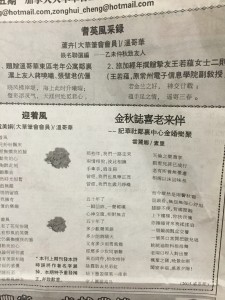
After that Elee asked people to comment about the “poetics of writing in community”. She is going to a conference in Thailand to talk about this idea and asked people to give reactions/ideas/successes and challenges about writing in a group like this. What works and why. Comments welcome!
October 29, 2015
We met at SFU Harbour Centre on the seventh floor with students from Professor Lucas Crawford’s Gender Studies class. Lucas and his partner Carmen and the students brought a massive buffet for us of home-cooked food, cheeses, pies, vegetables – it was bounty, and so welcoming.
Several of the SFU students, who take class out on the Burnaby campus, confessed they were quite nervous to be writing with us. We confessed some of us were nervous as well. Some of us have had bad experiences with academia that have scarred us or made us misjudge our abilities. Nerves are, perhaps, the great equalizer.
With the big room almost filled to capacity we started our exploration of food.
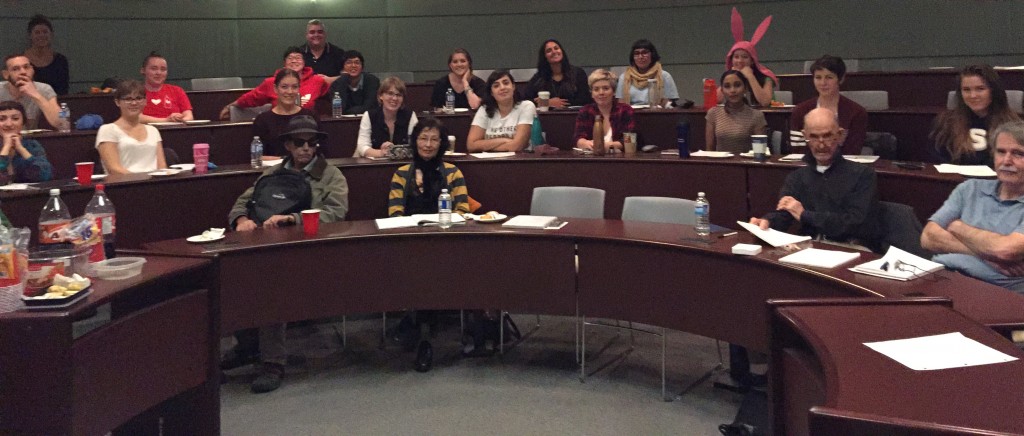
The first prompt was: In Kentucky, it is illegal to carry an ice cream cone in your back pocket.
We heard some riotous responses to this – challenges, counter arguments, suppositions, erotic ripostes…This prompt kept going and going and we heard from people who are naturally hesitant to read aloud. Quite fun to volley back and forth between the students and the DTES writers.
From there we began a short discussion of the idea of food rules. Cultural groups – whether they are big nations or small families – all have rules or unspoken guidelines around food. A familiar one here in Vancouver is putting the napkin in one’s lap.
Another example: the Jewish idea of keeping kosher, not mixing dairy and meat. Or the practice of the Aboriginal people in Australia about not eating during mourning. Or how in many language groups men and women eat separately. In some seasons when food is short, some people have preference over others for various types of food. Heart, liver, kidneys and other animal organs are often saved for the elders in the language groups.
What are the food rules you adhere to? What are the reasons we uphold food rules – cleanliness? Scarcity? Respect? Health? Control?
Our discussion was busy and fascinating, leaving time of only one more prompt: Invent/subvert or discuss a food rule.
Thank you to the wonderful students for welcoming us so warmly and sharing their creativity! We are excited to reunite on Nov 19 to hear revised/edited/completed versions of these prompts at our reunion dinner reading! Thank you, Lucas Crawford, for opening your class to us!
October 22, 2015
Writing Prompt: food you eat while walking
We discussed what wrote last week- recipes! – and heard some of those.
Writing prompt: while she was asleep she ate and ate
We discussed: food trucks. There are 31 in Vancouver open at the time I checked. There is a website that ranks the top 10 in Vancouver. One is Mom’s Grilled Cheese Truck. That is not the only Grilled Cheese Truck. There is a breakfast eggs truck, too.
October 15, 2015
We had a visit from Hives for Humanity today. Sarah Common and Jim came to talk with us about bees, therapeutic beekeeping and their hives in East Van.
Sarah brought a chunk of beeswax (front left), some lapel buttons, chunks of propolis, a miniature skep, a beeswax candle and a tray of honey from the different hives with tasting sticks.
Our first prompt was: bees communicate through the “waggle dance”
We heard an exciting range of pieces spanning first person bee monologues to an essay on social justice and feminism to a childhood memory of dancing to several astonishing sound poems and beyond.
Sarah spoke about what she brought and the idea of “therapeutic” beekeeping – the premise that being around the hives requires and begets a calm, focussed mind. The collectivity and community around the hives, with their gentle resonance and soothing beeswax smell, also heals. We hope to collaborate with and support Hives for Humanity though our writing – and they have invited us to visit in the spring for a field trip.
Here are some bee facts we learned:
There are 450 species of bees in BC and 20,000 in the world.
To make 1lb of honey bees have to fly 50,000 miles.
Worker bees live 4-5 days while queens live 5 years because they eat the nourishing super-food “royal jelly” which is excreted through the foreheads of younger bees.
Worker and queen bees are identical at birth; changes begin because she continues to eat royal jelly after day 3 of life.
Propolis is anti-fungal,-bacterial,anti-everything bad so bees spread it through the hive. They would coat and gum up the entire hive if they could. They allow it to build up at the entrance so incoming bees don’t track infection inside.
Sarah also brought a miniature “skep” which is the conical, familiar bee hive shape.
The tiny one she brought was woven from flax from the Hastings Urban Farm. She related how they were used in the past: the bees gathered inside and created a comb. When it was big enough the beekeeper would wring out the skep, getting all the honey but wasting the comb and killing all the bees! That’s why they aren’t used anymore, although they continue to be a “happy” symbol of idyllic beekeeping. If you look up around Hastings Street you may see tiny skeps hanging from flower baskets and over doors of bee-friendly businesses.
We tasted the honey from the different local hives. Each was delicious and entirely different from the next! It was fascinating to “taste” the neighbourhoods – Strathcona, Hastings St, Main St…
Thank you, Sarah and Jim, for sharing your passion with us!
October 8, 2015
Because we ran out of time last week and promised to bring in our last writing, our opening prompt was about interrupted or sustained conversation.
Prompt: as you were saying
We heard the rest of the texts from last week that we didn’t have a chance to share and also responses to “as you were saying.”
Next, we discussed the word recipe.
recipe: a set of instructions for making or preparing something, especially a food dish:
a medical prescription.
a method to attain a desired end: a recipe for success.
What are the characteristics of recipes? What do they need to have?
We talked about how there are things each of us know how to do to an expert level: ways of being, telling a joke, surviving a difficult situation, singing a song, building a snowman, taking the bus, patting your dog’s ears just the right way. We talked about what deep insider knowledge we each have – it may not be obvious at first but we all are experts on something.
Our prompt was to write a recipe for doing the thing you know/love to do. Make sure to specify ingredients, tools, sizes, temperatures, times. These can be literal, metaphysical or metaphorical. Maybe your recipe calls for a hectare of laughter or a pinch of nostalgia.
We didn’t get to this prompt but it could be fun: Write about a recipe gone wrong, only in terms of extremely unexpected results.
October 1, 2015
class 3, course 16
Prompt: Onion is Latin for ‘large pearl’.
Prompt: Pearls melt in vinegar.
Prompt: What other foods melt, dissolve, disappear, blend? Where does the cheese from the holes in swiss cheese go? In what way do people melt, dissolve, disappear or blend?
We began this prompt but didn’t have a chance to share it. We decided we would begin next class by reading our texts:
Prompt: In the Middle Ages, onions were such an important food that people would pay their rent with onions, and even give them as gifts. What can you imagine today that is so important/useful? Think metaphorically or fancifully. What could you buy today with onions? What if onions were that important now? What would our community look like? How would it change things?
Added bonus prompt we didn’t get to: Pete Wells, restaurant critic on the summer break from eating out and cooking at home: “Summer vacation is my chance to bleed on the onions again.”
September 24, 2015
class 2, course 16
We are the beneficiaries of some of the personal collection of books of Bud Osborn, the Bard of the Downtown Eastside. The Carnegie Library received books from Bud’s shelves, including his handwritten journals, and created a mini library of Bud’s books. The number of volumes is staggering. What they were unable to include they shared with the participants of Thursdays Writing Collective. The breadth and depth of Bud’s interests is fascinating – poetry from around the world, essays, tracts… Some of the books have personal annotations and bookmarks, which is moving. We’re so grateful to have this beautiful connection to a neighbourhood activist and thinker. Again, good reading leads to good writing. Thank you to Bud’s friends and family for sharing these precious volumes with us. And thank you, Carnegie Library and Nathalie, for making it happen!
Prompt: that old chestnut
We spoke about watching people in parks picking up chestnuts and how food is literally falling from the sky.
Next we shared some info:
We will be at WORD Festival Sunday – 11am-5pm inside the promenade. Participants are welcome to bring their self-published books to sell for their own profit. We will be selling the Collective’s publications.
Notice of Upcoming readings:
October 19: 7:00 p.m.
Panel: Breaking Tradition – Fighting for Job Equality Through the Generations
Vancouver Public Library Main Branch (Robson and Hamilton) with Bonnie Schmidt (ex–RCMP, author of Silenced: The Untold Story of the Fight for Equality in the RCMP), Louisa Robinson (Aircraft Maintenance Engineer) and Mariegold Rondeau (Heavy- Duty Mechanic)
October 22: 7:30 p.m. Launch of Rough Ground Revisited by Kate Braid with Sarah de Leeuw, Beth Kope and Arlene Paré Cottage Bistro 4468 Main St
Prompt: Elee handed each person one of two real horse chestnuts she picked up on her street and then read this info aloud:
The fruit is contained in a spiny (very sharp) cupule 5–11 cm in diameter, also called “bur” or “burr“.[24] The burrs are often paired or clustered on the branch[19] and contain one to seven nuts according to the different species, varieties, and cultivars.[1][2][25][26] Around the time the fruits reach maturity, the burrs turn yellow-brown and split open in two or four sections. They can remain on the tree longer than they hold the fruit, but more often achieve complete opening and release the fruits only after having fallen on the ground; opening is partly due to soil humidity.[6]
The chestnut fruit has a pointed end with a small tuft at its tip (called “flame” in Italian[6]), and at the other end, a hilum – a pale brown attachment scar. In many varieties, the fruit is flattened on one or two sides. It has two skins. The first one is a hard, shiny, brown outer hull or husk, called the pericarpus;[27] the industry calls this the “peel”.[6] Underneath the pericarpus is another, thinner skin, called the pellicle or episperm.[27] The pellicle closely adheres to the seed itself, following the grooves usually present at the surface of the fruit. These grooves are of variable sizes and depths according to the species and variety.
The fruit inside these shows two cotyledons with a creamy-white flesh throughout,[8] except in some varieties which show only one cotyledon, and whose episperm is only slightly or not intruded at all. Usually, these varieties have only one large fruit per burr, well rounded (no flat face) and which is called “marron”[6] (marron de Lyon in France, marron di Mugello in Italy, or paragon).
Chestnut fruit have no epigeal dormancy and germinate right upon falling to the ground in the autumn, with the roots emerging from the seed right away and the leaves and stem the following spring. Because the seeds lack a coating or internal food supply, they lose viability soon after ripening and must be planted immediately.
Today, the nut’s demand outstrips supply. The United States imported 4,056 metric tons of European in-shell chestnuts worth $10 million in 2007
Chestnuts depart from the norm for culinary nuts in that they have very little protein or fat, their calories coming chiefly from carbohydrates. Fresh chestnut fruits have about 180 calories[41] (800 kJ) per 100 grams of edible parts, which is much lower than walnuts, almonds, other nuts and dried fruit (about 600 kcal/100 g).[41] Chestnuts contain very little fat, mostly unsaturated, and no gluten.[10]
Their carbohydrate content compares with that of wheat[38] and rice; chestnuts have twice as much starch as the potato on an as-is basis.[32] In addition, chestnuts contain about 8% of various sugars, mainly sucrose, glucose, fructose, and, in a lesser amount, stachyose and raffinose, which are fermented in the lower gut, producing gas.[6] In some areas, sweet chestnut trees are called “the bread tree”.[41][53] When chestnuts are just starting to ripen, the fruit is mostly starch and is very firm under finger pressure from the high water content. As the chestnuts ripen, the starch is slowly converted into sugars, and moisture content also starts decreasing. Upon pressing the chestnut, a slight ‘give’ can be felt; the hull is not so tense, and space occurs between it and the flesh of the fruit.[54] They are the only “nuts” that contain vitamin C, with about 40 mg per 100 g of raw product, which is about 65% of the U.S. recommended daily intake. The amount of vitamin C decreases by about 40% after heating. Fresh chestnuts contain about 52% water by weight, which evaporates relatively quickly during storage; they can lose even 1% of weight in one day at 20 °C (68 °F) and 70% relative humidity.[6]
Tannin is contained in the bark[55][56] as well as in the wood, leaves, and seed husks. The husks contain 10–13% tannin.[56]
Because of their high water content, transpiration rates and consequent loss weight, the nuts react as fresh fruits (not as nuts). They should be kept cool at all times, including in shops when on display for sale.[52]
The fruit can be peeled and eaten raw, but it can be somewhat astringent, especially if the pellicle is not removed.[73]
Another method of eating the fruit involves roasting, which does not require peeling. Roasting requires scoring the fruit beforehand to prevent explosion of the fruit due to expansion. Once cooked, its texture is slightly similar to that of a baked potato, with a delicate, sweet, and nutty flavour.
(from https://en.wikipedia.org/wiki/Chestnut)
People then wrote about what they noticed of the chestnut in front of them, or something about what they heard.
Prompt: Always served as part of the New Year menu in Japan, chestnuts represent both success and hard times—mastery and strength.[16] The Japanese chestnut (kuri) was in cultivation before rice[43] and the Chinese chestnut (C. mollissima) possibly for 2,000 to 6,000 years.[10]https://en.wikipedia.org/wiki/Chestnut
Prompt: The multiuses of the chestnut: “Fabric can be starched with chestnut meal.[18] Linen cloth can be whitened with chestnut meal.[18] The leaves and the skins (husk and pellicle) of the fruits provide a hair shampoo.[38][89]”
Prompt: “It is splendid to be a great writer, to put men into the frying pan of your imagination and make them pop like chestnuts.” – Author: Gustave Flaubert
First Class – September 17, 2015
The first prompt on the board was: what to feed on (10 mins)
We had a packed class so we limited the reading aloud to three volunteers. We heard some beautiful metaphysical ideas about “swallowing the full moon” and “the honey of kindness”.
Next we shared some info or “housekeeping” notes:
Books from Bud Osborn’s personal collection are downstairs in a mini library within the Carnegie Community Centre branch. Nathalie, the librarian, has invited us all to explore his handwritten journals and books.
We handed out about 50 books from a local poet who read for an award and donated her copies to us. Thank you! Amazing reading material!
We spoke about Sustain and Nourish plans
- a visit from Hives for Humanity to write about honey and bees
- planning our Literary Verses and Courses dinners of social writing
- reading at the Food Bank
- Our participation in the Heart of the City Festival – a possible remount of a Voice to Voice concert, or possible reading
- We will have a table at WORD Festival thanks to SFU’s Writing and Publishing Program. It’s on Sunday 27th at the Main Library Branch in Vancouver. We began signing up volunteers to staff the table.
- more contributors purchased Voice to Voice books at cost to sell them for profit
Then back to the writing:
First we discussed this idea:
Food politics are the political aspects of the production, control, regulation, inspection, distribution and consumption of food.-Wikipedia
What are the issues or problems that concern you? We heard about Sunday night dinner on the reserve as being the only hiatus in family fights, growing up in hereditary poverty and eating processed foods, the feeling of being separated from the production and control of the food we eat, the concept of justice not charity concerning donated food/food banks, the politics of extreme food beliefs (orthorexia), strong beliefs about food that separate families, allergies/sensitivities, judgement around where one spends a welfare food allowance, and many other topics.
After the discussion we turned to write about what we discussed.
The next prompt was the definition of “sustain”:
to strengthen or support physically or mentally.
2 synonyms: comfort, help, assist, encourage, succor, support, give strength to, buoy up, carry, cheer up, hearten; informalbuck up “her memories sustained her”
4cause to continue or be prolonged for an extended period or without interruption.”he cannot sustain a normal conversation”
undergo or suffer (something unpleasant, especially an injury).”he died after sustaining severe head injuries”
(of a performer) represent (a part or character) convincingly.”he sustained the role with burly resilience”
an effect or facility on a keyboard or electronic instrument whereby a note can be sustained after the key is released.
bear (the weight of an object) without breaking or falling.”he sagged against her so that she could barely sustain his weight”
Then we tackled the definition of “nourish”:
to provide with the food or other substances necessary for growth, health, and good condition.”I was doing everything I could to nourish and protect the baby”
2 synonyms:
3feed, provide for, sustain, maintain “patients must be well nourished”
4▪enhance the fertility of (soil).”a clay base nourished with plant detritus”
2.
keep (a feeling or belief) in one’s mind, typically for a long time.”he has long nourished an ambition to bring the show to Broadway”
7 synonyms:
8cherish, nurture, foster, harbor, nurse, entertain, maintain, hold, have “the hopes Emma nourished”
We heard some exceptional writing about GMOs, sneaking food from low supplies at home, the routine of food, feelings of shame and guilt around food issues. It was riveting how quickly the personal and the political came together. We cautioned each other to continue our respectful conversations during this year as we can sense how many issues are embedded in this topic. This mutually supportive and very sensitive group of writers is so skilled at creating a generative space for everyone. It was a great start to a very multidimensional project!

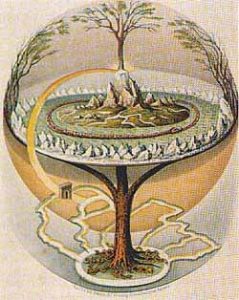
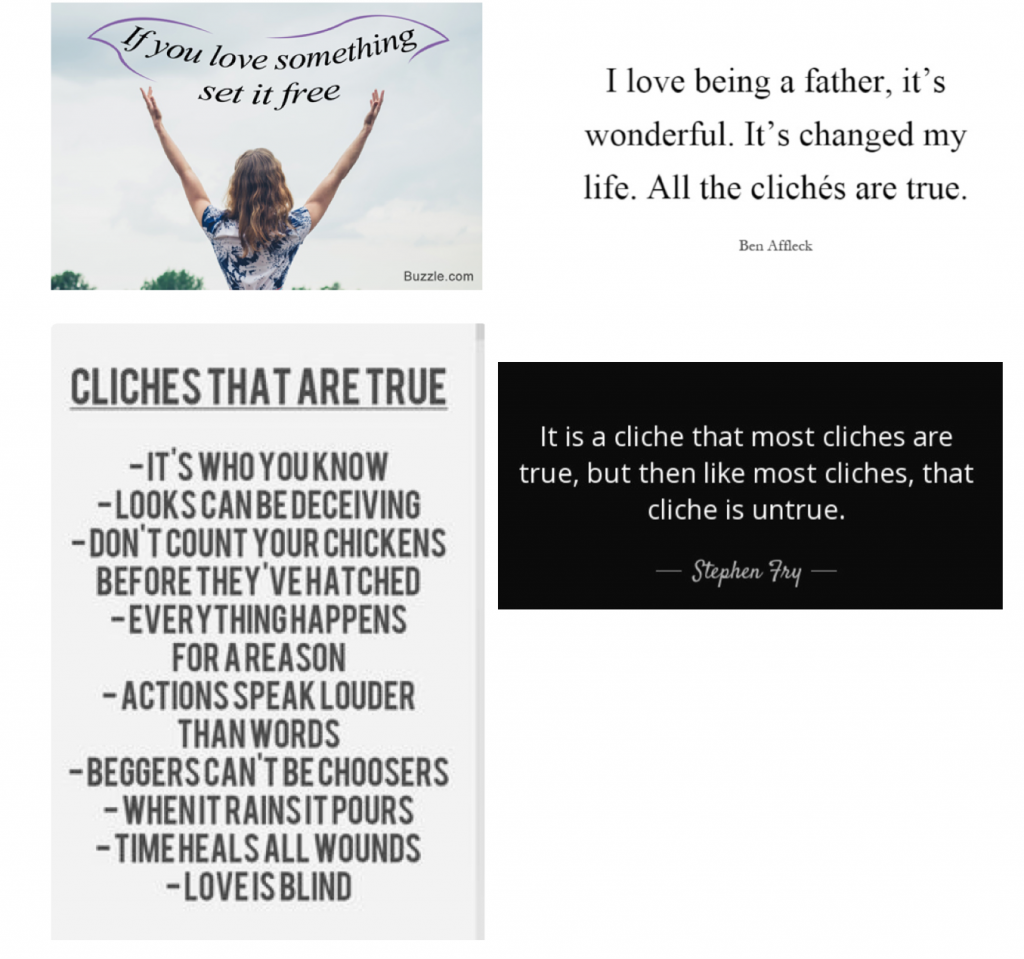


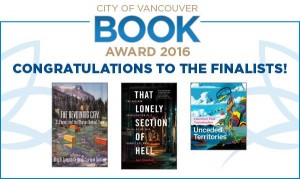
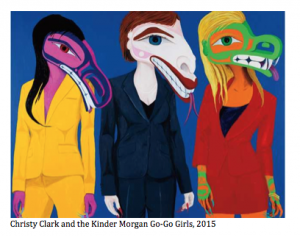
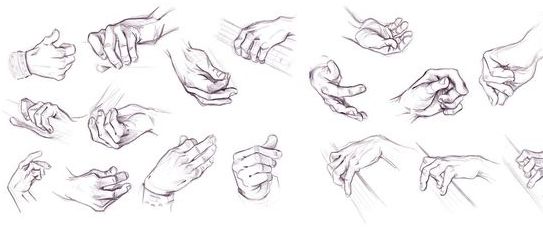
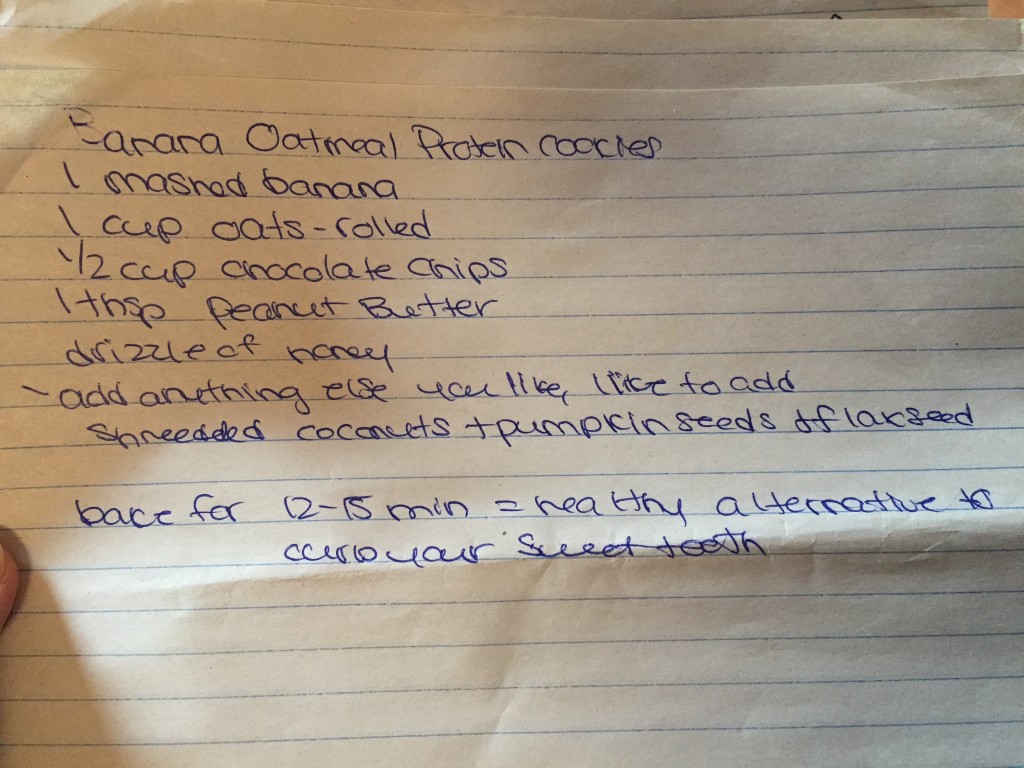
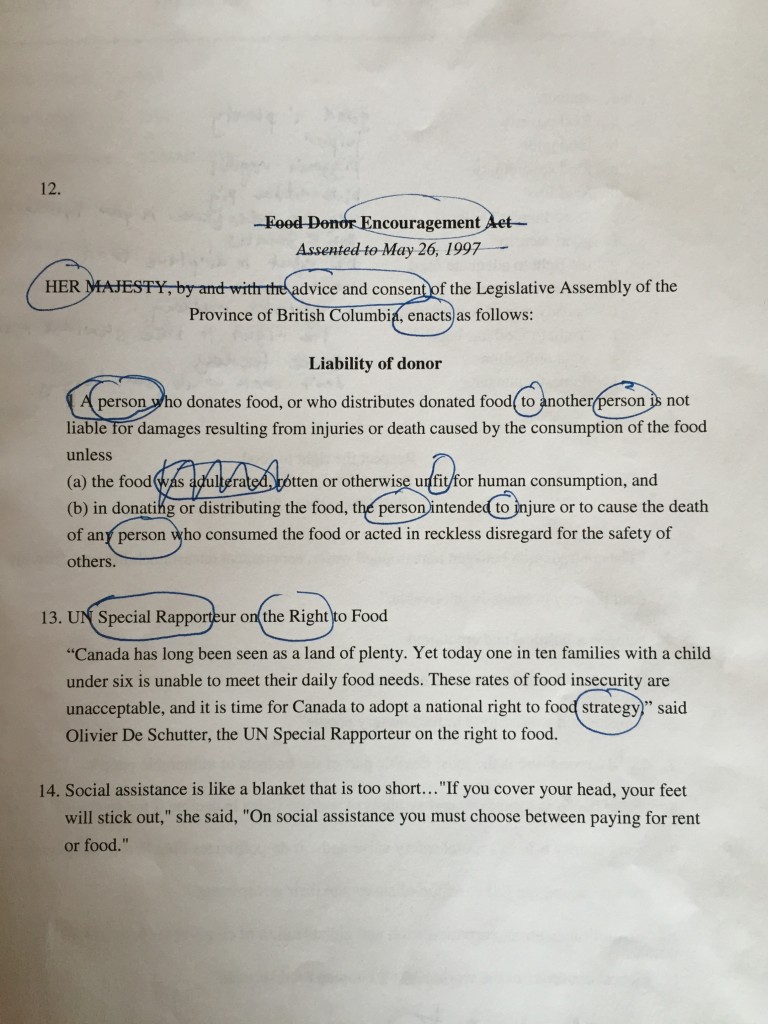
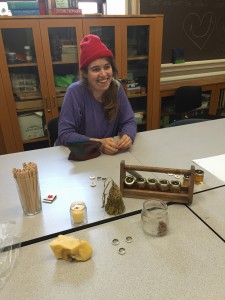
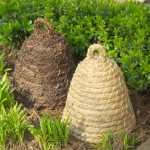
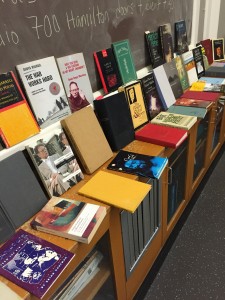
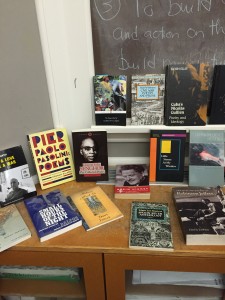
 Facebook
Facebook